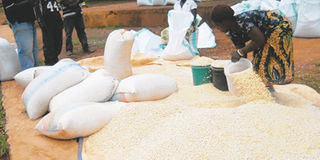Aflatoxins affect African food exports, experts say

The risk of aflatoxin contamination begins with planting and can be worsened later through inappropriate harvesting,handling,storage,processing and transport practices,TFDA says. PHOTO|FILE
What you need to know:
- This is mainly due to stringent regulations on Aflatoxin regulation, which limits how much produce enters the global market.
Nairobi. Aflatoxin, a poisonous and cancer-causing chemicals produced by certain molds which grow in grains, is a barrier to food exports from Africa and threat to human health, according to a senior East African Community (EAC) official.
This is mainly due to stringent regulations on Aflatoxin regulation, which limits how much produce enters the global market.
“The entire African continent is susceptible to Aflatoxin contamination and that its high incidence continues to pose threat to human and animal health”, the EAC deputy secretary general in charge of Economic and Social Sectors, Ms Jesca Eriyo, said in a speech availed to The Citizen.
She gave the warning in her keynote address to the Second Partnership for Aflatoxin Control in Africa (Paca) Platform meeting currently underway in Entebbe, Uganda.
She quoted latest report by experts, who estimate that losses from Aflatoxin in Africa have escalated to the tune of $450 million each year due to stringent standards by the European Union (EU) alone.
Ms Eriyo further warned that the poisonous chemical was one of the challenges that the African continent need to address in order to achieve global developmental aspirations such as the African Union
(AU) Agenda 2063.
The toxic material is regularly found in improperly stored staple commodities such as cassava, chili peppers, corn, cotton seed, millet, peanuts, rice, sorghum, sunflower seeds, tree nuts, wheat, and a variety of spices.
Other development goals for the continent that may be affected by the the toxic material include Sustainable Development Goals (SDGs), and the continental goals and targets contained in the 2014 African Union Heads of State Malabo Declaration on Accelerated Agricultural Growth and Transformation for Shared Prosperity and Improved Livelihoods.
“EAC is also committed to the implementation of the Malabo Declaration. The overarching commitments in the Malabo Declaration include ‘Commitment to Ending Hunger in Africa by 2025’ and the Commitment to Boosting Intra-African Trade in Agricultural commodities and services. These commitments are pertinent to and of great relevance to the EAC integration process,” she said.
Ms Eriyo, nevertheless,informed the conference participants that the EAC Aflatoxin Prevention and Control Initiative was launched in March 2014, with the overall focus of mitigating the adverse impacts of Aflatoxin along the food and feed value chains in the region.
She said the initiative was anchored in the EAC Treaty, the Common Market Protocol, the Protocol on Sanitary and Phyto-sanitary (SPS) Measures and other EAC Instruments of Regional Integration.
“Safeguarding human, animal and plant health and ensuring safe trade in agricultural products in the EAC and other trading partners is a key provision in the SPS Protocol.”
The Senegalese’ minister of Commerce, Informal Sector, Consumption, Promotion of Local Products and SMEs Alioune Sarr, reaffirmed his country’s commitment to fight and contain Aflatoxin contamination in Senegal and Africa as a whole.
Uganda’s minister of Agriculture, Animal Industry and Fisheries, Ssempijja Bamulangaki, outlined the achievements Uganda has made in the fight against aflatoxin contamination, while his counterpart for Trade, Industry and Cooperatives, Amelia Kyambadde, decried the low levels of public awareness on the effects of Aflatoxin.
The 2nd PACA Platform meeting brought together over 300 senior government officials from AU Member States mainly from government Ministries of agriculture, trade, and health, farmers organization, consumer associations, large and small business sector representatives, civil society, development partners, donor communities, the AU, and Regional Economic Communities in Africa.
Aflatoxins in Tanzania
Aflatoxins is common in Tanzania. Experts say countries that are located between 40ºN and 40ºS latitude (Tanzania included) offer suitable growing conditions for the fungi.
Early this year 14 people died in Dodoma and Manyara after eating cereals that were contaminated with the toxin. Results of laboratory tests conducted by The US-based Centre for Disease Control (CDC) on blood and urine samples of people who died or fell ill revealed shocking levels of aflatoxins.
CDC said samples showed high levels of contamination of Aflatoxin B1, which damages the liver. The level of aflatoxins was found by the CDC to be about 200 parts per billion (ppb), while the human body can only withstand 5ppb levels.
The risk of aflatoxin contamination begins with planting, and can be worsened later through inappropriate harvesting, handling, storage, processing, and transport practices, a Tanzania Food and Drugs Authority (TFDA) says.
Aflatoxins can enter the human diet through direct consumption of cereals or through consuming livestock products if the livestock are given contaminated feed. Children can be affected through breast milk or direct consumption of weaning foods. Some experts suspect association of aflatoxin exposure with child stunting and greater susceptibility to human immunodeficiency virus (HIV), tuberculosis, and malarial infection.
Prevalence of Aflatoxins in Tanzania
The Tanzania Bureau of Standards (TBS) sets standards on many food commodities, taking into account global standards as well as national production and consumption patterns.
While it is generally recognized globally that there is no ―safe level of aflatoxin exposure, TBS has set the maximum acceptable limit for maize grain and groundnuts at 10ppb for total aflatoxins and 5 ppb for B1.
The World Health Organization estimates that in 2010 there were
1,209 liver cancer cases in Tanzania. This implies that at average contamination of 5ppb, in 2010 as many as 45 per cent of annual liver cancer cases in Tanzania could be attributed to aflatoxins.
Aflatoxin B1 prevalence data from 2012 indicates contamination above regulated levels (5 ppb) in two zones.
In the Eastern zone (Morogoro), 43 per cent of the maize samples were above 5 ppb; and in the Western zone (Shinyanga), 40 per cent of the samples were above 5 ppb, with average contamination of 50 ppb and 28 ppb, respectively.
The contamination was much lower in other zones: In the Northern zone (Manyara), 9 per cent of the samples were above 5 ppb; In the Southern Highlands (Iringa, Mbeya, and Rukwa), only 4 per cent were above 5 ppb; and in the Southern zone (Ruvuma), none of the samples were above 5 ppb.
The groundnut samples had more limited geographical coverage. Percentages of samples from the Northern, Southern (Mtwara), and Western zones with aflatoxin B1 contamination above 5 ppb were 20 per cent, 20 per cent, and 8 per cent, respectively, with mean contamination at 20 ppb, 18 ppb, and 20 ppb.
In summary, prevalence data from 2012 suggest that aflatoxin contamination is a major concern only in the Eastern and Western zones. Prevalence testing is needed in other areas where data are not currently available to establish a fuller picture for the country.
Since environmental conditions determine aflatoxin prevalence, testing in several years is needed to confirm whether aflatoxin prevalence can be a concern in other regions and to ensure that 2012 was not an atypical year.




